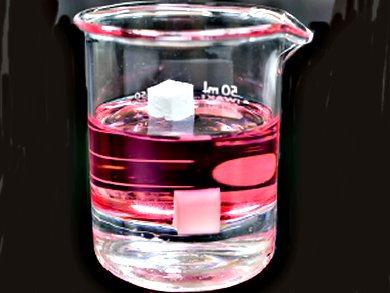Hydrophobic and oleophobic surfaces are drawing increasing attention because of the growing demands for applications such as anti-fingerprint touch panels on electronic devices and solar panels that can prevent output fall from dust and smears on the surface by the self-cleaning effect. In nature, many examples of superhydrophobic surfaces exist, such as eyes of mosquitos and lotus leaves.
Kazuyoshi Kanamori and colleagues, Kyoto University, Japan, employed a vinyltrimethoxysilane (VTMS)-vinylmethyldimethoxysilane(VMDMS) co-precursor system to prepare the first superamphiphobic monolith. It shows a contact angle greater than 150° for both water and organic liquids, such as ethylene glycol, formamide, diiodomethane, 1-bromonaphthalene, and n-hexadecane. Co-continuous macroporous structure covered with perfluoro-alkyl groups supplies roughness and low surface energy, resulting in superamphiphobicity on any cutting surfaces of the monolith.
The VTMSVMDMS marshmallow-like gel can be obtained in a facile manner by a combination of the simple one-pot sol–gel process and the thiol–ene click reaction.
The authors expect this unique and outstanding monolithic material to pioneer the scientific and technological interests of three-dimensional superamphiphobic materials. Furthermore, novel applications to new self-cleaning and antifouling surfaces, gas-permeable separators, medical/biomedical materials, and selective separation media for organic liquid would be developed by carefully tuning the surface energy and roughness of the monolith.
- A Superamphiphobic Macroporous Silicone Monolith with Marshmallow-like Flexibility,
Gen Hayase, Kazuyoshi Kanamori, George Hasegawa, Ayaka Maeno, Hironori Kaji, Kazuki Nakanishi,
Angew. Chem. Int. Ed. 2013.
DOI: 10.1002/anie.201304169




